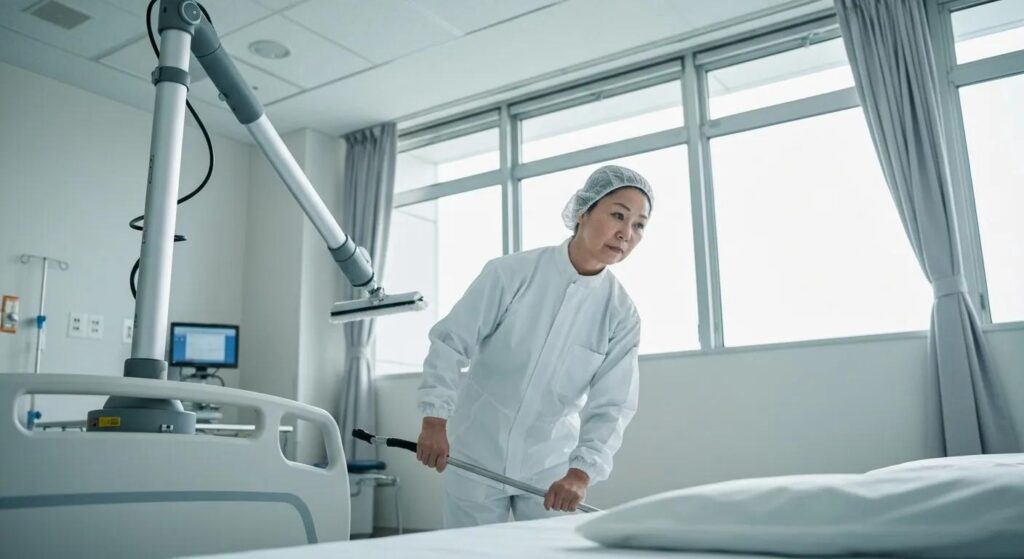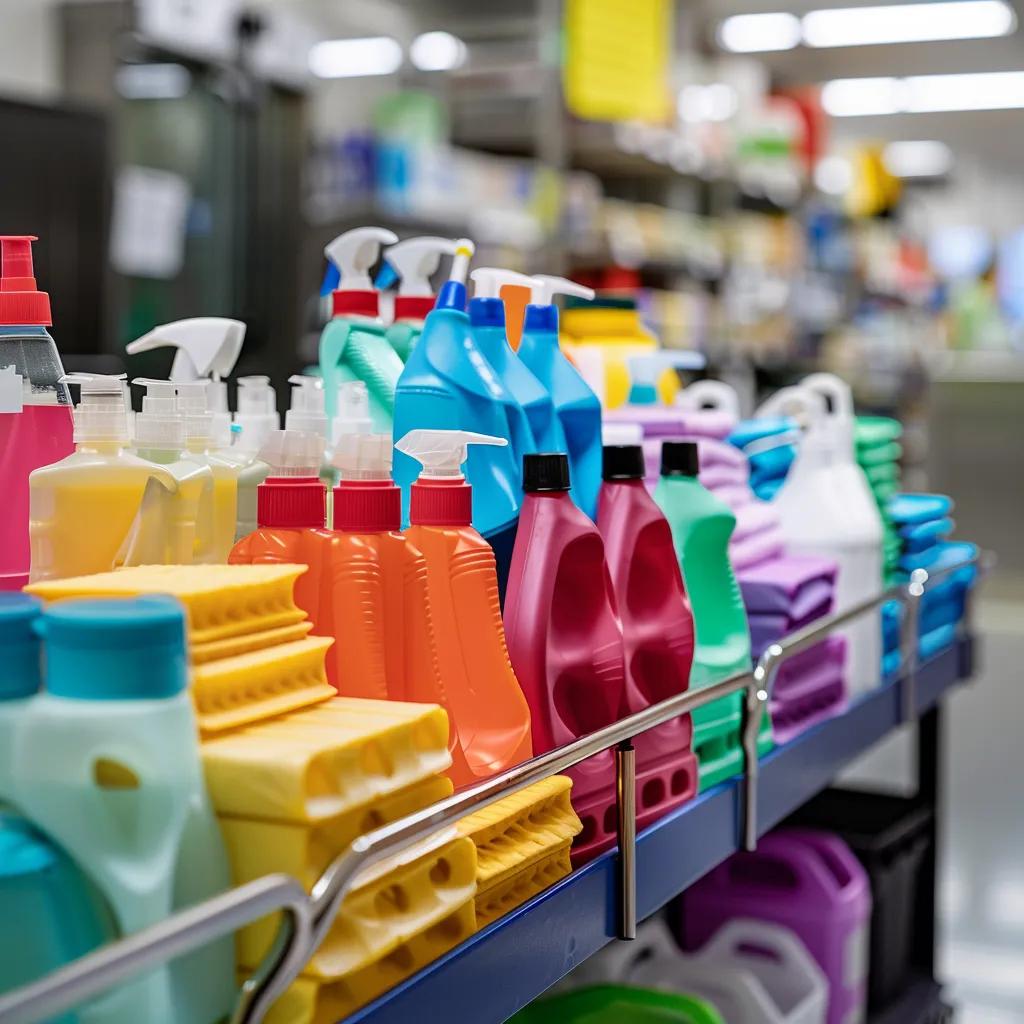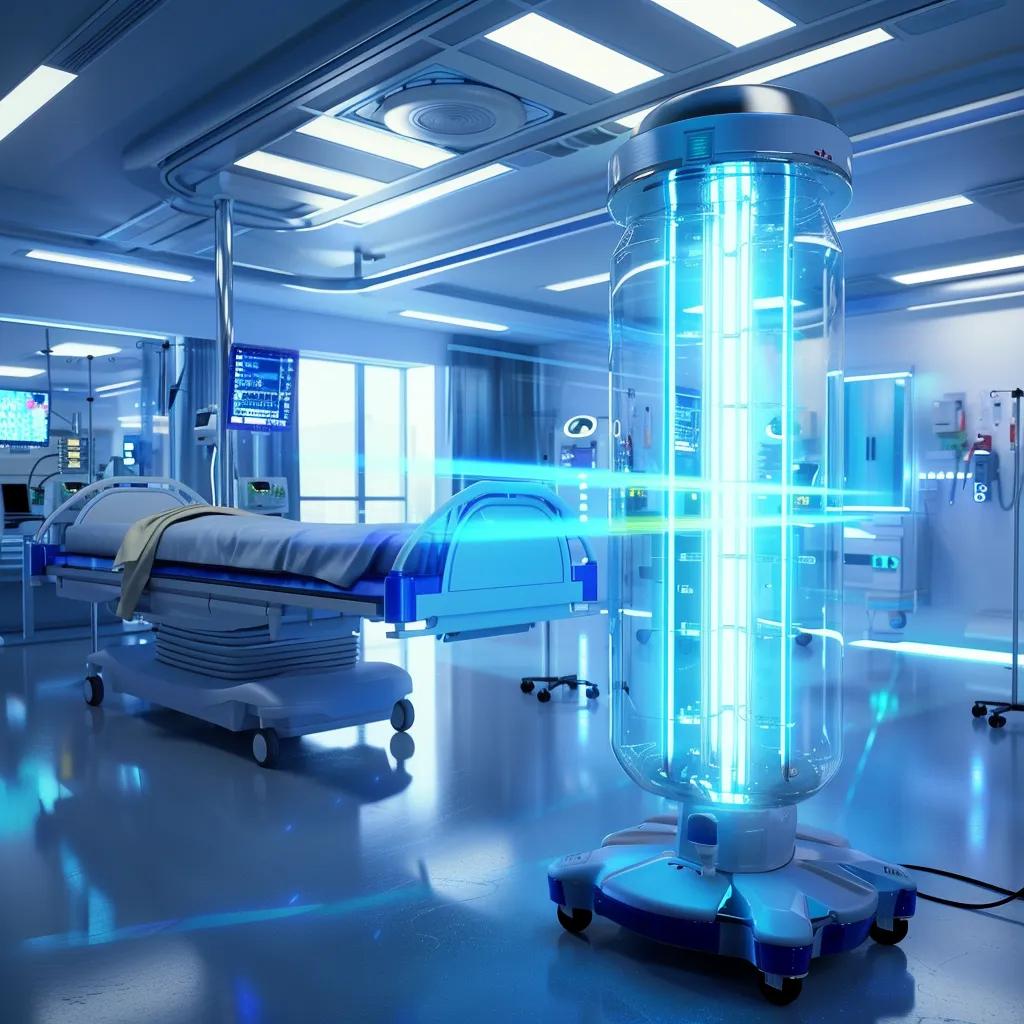
Commercial Cleaning Solutions for Hospitals Explained: Comprehensive Guide to Infection Control and Safety

Hospitals combat an average of 1 in 31 patients acquiring a healthcare-associated infection (HAI) every day, making rigorous
for hospitals essential for patient safety and regulatory compliance. In this guide, you will discover proven infection control protocols, step-by-step cleaning procedures, EPA-approved disinfectants, advanced technologies, staff training standards, and local customization strategies that ensure sterile, safe environments. We’ll explore:
- Core infection control measures and EVS roles
- Detailed cleaning protocols for patient rooms, ORs, high-touch surfaces, and waste
- Effective hospital-grade disinfectants and safe chemical handling
- UV, electrostatic, and essential equipment innovations
- CDC/OSHA regulations, EVS training, and quality audits
- Tailored service offerings for Macomb, Oakland, and Metro Detroit hospitals
- Answers to top concerns on hospital cleaning practices
Throughout, McCoy Maintenance’s local expertise and commitment to EPA-approved products support each protocol, ensuring optimal outcomes for medical facilities in Metro Detroit.
What Are the Key Hospital Infection Control Protocols for Effective Cleaning?

Rigorous infection control protocols define how cleaning teams prevent pathogen transmission, protect patients, and comply with healthcare standards. These protocols integrate environmental services workflows, hand hygiene, surface disinfection, and cross-contamination prevention to reduce HAIs and safeguard public health.
Before detailing specific practices, consider these foundational measures:
- Hand Hygiene Compliance: Strict adherence to washing or sanitizing with CDC-recommended formulations.
- Surface Risk Zoning: Categorizing low-, medium-, and high-risk areas to prioritize cleaning frequency.
- Personal Protective Equipment (PPE): Use of gloves, gowns, masks, and eye protection during all cleaning tasks.
- Waste Segregation: Color-coded containers for sharps, biohazard, and general refuse to prevent exposure.
These core elements establish a framework for targeted protocols that directly reduce healthcare-associated infections and guide all subsequent cleaning steps.
How Do Hospitals Prevent Healthcare-Associated Infections (HAIs)?
Healthcare-Associated Infections (HAIs) are prevented by combining environmental sanitation, antimicrobial stewardship, and staff education. Environmental Services (EVS) teams implement systematic cleaning services, use EPA-registered disinfectants, and monitor microbial load to interrupt pathogen transmission and ensure patient safety.
By integrating microbial testing and data-driven audits, hospitals maintain low HAI rates and satisfy Joint Commission standards, paving the way for precise terminal and routine cleaning procedures.
What Are the Best Practices for Hand Hygiene in Hospital Cleaning?
Effective hand hygiene involves using alcohol-based hand rubs with at least 60% ethanol or washing with antimicrobial soap for a minimum of 20 seconds. Cleaning staff cleanse hands before donning gloves, after glove removal, and between different cleaning zones to eliminate transient flora and reduce cross-contamination risks.
Consistent compliance audits, wall-mounted dispensers at patient-room entrances, and visual reminders reinforce these practices, directly decreasing pathogen spread and improving overall infection control.
How Is Cross-Contamination Prevented in Healthcare Environments?
Preventing cross-contamination relies on strict segregation of cleaning tools and workflows: color-coded microfiber cloths for different risk zones, single-use disposable wipe systems, and dedicated mops for isolation rooms. EVS staff follow unidirectional cleaning patterns—from clean to dirty areas—to avoid transferring pathogens. To learn more about effective cleaning strategies, visit office cleaning.
Tool management protocols and daily equipment decontamination ensure that cleaning devices do not become vectors for microbial transmission, reinforcing a controlled environment.
What Role Does Environmental Services (EVS) Play in Hospital Infection Control?
Environmental Services teams serve as frontline guardians, executing standardized cleaning protocols, performing daily disinfection rounds, and documenting compliance. EVS staff collaborate with infection preventionists to update procedures, conduct microbiological swabbing, and adjust cleaning frequency based on patient acuity and outbreak alerts.
Their coordination with clinical teams and use of validated checklists uphold environmental hygiene standards and directly protect vulnerable patients, leading seamlessly into specialized terminal cleaning processes.
What Are the Essential Hospital Cleaning Protocols and Procedures?
Hospital cleaning protocols extend from daily room turnover to specialized operating room sanitation. Each procedure combines precise methods, EPA-approved agents, and competency-based training to maintain sterile conditions and meet accreditation requirements.
What Is Terminal Cleaning and How Is It Performed in Patient Rooms?
Terminal cleaning is a comprehensive sanitation process conducted after patient discharge or transfer. It involves:
- Removing all disposable items and linens
- Dusting and wiping walls, vents, and elevated surfaces
- Disinfecting high-touch points (bedrails, call buttons, switches) with EPA-registered solutions
- Cleaning floors with a two-step mop system—detergent followed by disinfectant
Terminal cleaning restores rooms to baseline sterility, preventing residual pathogen reservoirs and preparing the space for the next patient.
How Are High-Touch Surfaces Disinfected in Hospitals?
High-touch surfaces require frequent disinfection using dwell-time-validated disinfectants that kill 99.999% of pathogens. EVS staff apply solutions with microfiber cloths, ensuring full surface coverage and adherence to manufacturer-specified contact times. For more information, please visit our commercial cleaning services page.
Regular surface swabbing and ATP bioluminescence testing confirm efficacy, sustaining a hygienic environment and linking directly to operating room sanitation standards.
What Are the Standards for Operating Room Cleaning?
Operating Room (OR) cleaning follows exacting protocols:
- Pre-procedure wipe-downs of surgical tables and lights
- Post-procedure decontamination with high-level disinfectants on all equipment
- Air filtration system checks and HEPA filter maintenance
- Terminal floor scrub and vacuuming using hospital-grade HEPA vacuums
These steps align with AORN guidelines, minimize surgical site infection risks, and transition logically into waste management controls.
How Is Waste Managed Safely in Healthcare Facilities?
Medical waste management classifies refuse into regulated medical waste (RMW), sharps, pharmaceuticals, and general trash. EVS staff use puncture-resistant sharps containers, autoclave RMW on-site or engage licensed haulers, and segregate cytotoxic waste per OSHA rules.
Documented chain-of-custody protocols and regular compliance audits ensure safe disposal, concluding the procedural workflow and preparing for product and disinfectant selection.
Which EPA-Approved Disinfectants and Cleaning Products Are Used in Hospitals?
Hospital-grade disinfectants target a broad spectrum of pathogens, from enveloped viruses to spore-formers. Selecting EPA-registered chemicals, verifying label claims, and following dilution guidelines underpin safe, effective disinfection.
Below is a comparison of common hospital disinfectants:
| Entity | Attribute | Value |
|---|---|---|
| Quaternary Ammonium Compounds | Mechanism | Disrupts cell membranes |
| Hydrogen Peroxide (Accelerated) | Spectrum | Bactericidal, virucidal, sporicidal |
| Sodium Hypochlorite (Bleach) | Use Case | Surface decontamination in non-sensitive areas |
| Phenolic Solutions | Material Compatibility | Suitable for metal and plastic surfaces |
What Types of Hospital-Grade Disinfectants Are Most Effective?
Hospital-grade agents include quats for routine surfaces, accelerated hydrogen peroxide for rapid sporicidal action, and bleach for high-risk spills. Selection depends on surface compatibility, organic load tolerance, and contact-time requirements.
Pairing the right chemistry with facility risk assessments guarantees targeted germ elimination and supports precise application protocols.
How Are Disinfectants Properly Applied in Medical Facilities?
Disinfectant application requires three steps: surface pre-cleaning to remove soil, correct dilution per label, and ensuring required contact time before wiping or allowing to air-dry. EVS teams use color-coded buckets and automated dilution systems to maintain consistent concentrations and minimize chemical exposure.
This methodical approach preserves material integrity and maximizes antimicrobial performance.
What Are the Safety Protocols for Handling Cleaning Chemicals in Hospitals?
Chemical safety protocols mandate use of PPE—gloves, goggles, and respirators as needed—alongside Safety Data Sheet (SDS) training. Spill kits, eyewash stations, and local exhaust ventilation reduce inhalation risks and prevent dermal exposure.
Regular refresher training and routine inspections foster a culture of chemical safety, leading naturally into McCoy Maintenance’s compliance safeguards.
How Does McCoy Maintenance Ensure Use of EPA-Approved Products?
McCoy Maintenance exclusively procures EPA-registered disinfectants, validates each batch against label efficacy claims, and logs product lot numbers for traceability. Technicians receive quarterly in-service updates on new approvals and label changes, ensuring all cleaning agents meet or exceed hospital standards.
This rigorous product stewardship underpins consistent infection control outcomes across Macomb, Oakland, and Metro Detroit facilities.
How Do Advanced Cleaning Technologies Enhance Hospital Cleaning Solutions?

Innovative technologies like UV-C radiation and electrostatic sprayers augment manual cleaning, reaching hidden surfaces and improving disinfection consistency. Integrating these tools reduces manual labor, shortens room turnover times, and strengthens infection control.
What Is the Role of UV Light and Electrostatic Sprayers in Hospital Disinfection?
UV-C devices emit germicidal wavelengths that break microbial DNA bonds, providing no-touch disinfection for patient rooms and ORs. Electrostatic sprayers charge droplets so they uniformly coat surfaces and wrap around equipment.
Together, these technologies achieve up to 99.99% pathogen reduction in less time, supporting faster room availability and enhanced microbial control.
Which Essential Cleaning Equipment Is Used in Medical Facilities?
- Microfiber mops and cloths for superior soil pick-up
- HEPA-filtered vacuum cleaners to capture airborne particles
- Automatic floor scrubbers with precise chemical dosing
- Backpack sprayers for targeted disinfectant application
This equipment suite ensures thorough cleaning across diverse hospital zones and transitions smoothly into discussions of efficiency and infection control.
How Does Technology Improve Efficiency and Infection Control?
Automation reduces manual touchpoints, while data-enabled devices log disinfectant cycles and exposure times. Real-time monitoring dashboards alert supervisors to missed areas, driving accountability and continuous improvement.
Implementing these innovations not only elevates environmental hygiene but also supports regulatory documentation and performance metrics.
What Training and Regulatory Compliance Are Required for Hospital Cleaning Staff?
Well-trained EVS personnel understand infection control science, safety standards, and regulatory requirements that govern hospital sanitation. Structured education and ongoing assessments maintain certification and align practices with federal guidelines.
What Specialized Training Do Environmental Services Staff Receive?
EVS staff complete modules on bloodborne pathogens, aseptic techniques, spill response, and HIPAA-related cleanliness impacts. Training includes hands-on demonstrations of disinfection equipment, correct PPE use, and waste handling procedures.
Competency evaluations and supervised field assessments ensure each technician applies protocols correctly, establishing a foundation for quality assurance.
How Do CDC and OSHA Guidelines Influence Hospital Cleaning Practices?
CDC guidelines define hand hygiene, environmental cleaning frequencies, and outbreak response procedures, while OSHA standards dictate chemical handling, PPE requirements, and employee safety. Hospitals integrate both sets of rules into their cleaning manuals and EVS checklists.
Adherence to these regulations reduces occupational hazards and aligns sanitation efforts with national healthcare mandates. Consider an office cleaning service
What Quality Assurance and Auditing Processes Ensure Cleaning Standards?
Quality assurance programs include random ATP surface testing, fluorescent marker audits, and regular leadership walkthroughs using digital inspection tools. Audit results generate performance reports, highlight training needs, and track compliance trends over time.
These data-driven reviews reinforce continuous improvement and staff accountability.
How Does McCoy Maintenance Maintain Staff Certification and Expertise?
McCoy Maintenance tracks certification expiry dates, provides quarterly refresher courses on CDC/OSHA updates, and hosts annual competency fairs that simulate high-risk cleaning scenarios. Instructors include infection prevention specialists who ensure hands-on skills remain sharp. For more details, visit McCoy Maintenance.
This investment in people confirms that local hospitals receive expertly trained teams dedicated to superior infection control.
How Are Commercial Cleaning Services Customized for Hospitals in Macomb, Oakland, and Metro Detroit?
Local hospitals face region-specific challenges—from seasonal spikes in respiratory infections to varying county disposal regulations.
adapts service plans to address these nuances, ensuring consistent hospital-grade sanitation across Metro Detroit.
What Unique Cleaning Challenges Do Hospitals Face in Metro Detroit?
Metro Detroit hospitals contend with high patient volumes during flu season, aging facility infrastructure requiring specialized equipment access, and local water hardness that affects disinfectant efficacy. These factors demand flexible schedules, corrosion-resistant tools, and chemical adjustment protocols.
Understanding these local variables enables tailored cleaning strategies that maintain safety and compliance year-round.
How Does McCoy Maintenance Tailor Cleaning Contracts for Medical Facilities?
Contracts begin with a comprehensive facility audit, risk-zone mapping, and workflow analysis. Service agreements specify frequency of terminal cleaning, dedicated EVS staffing levels, and technology integration (e.g., UV-C cycles per week). Custom KPIs ensure accountability for key metrics like ATP reduction and room-turn time. Commercial cleaning services are essential for maintaining a safe and healthy environment.
This bespoke approach aligns resources with each hospital’s operational and regulatory demands.
What Are Examples of Successful Hospital Cleaning Projects Locally?
McCoy Maintenance restored a 200-bed hospital wing to 99.8% surface cleanliness within 48 hours using electrostatic sprayers and accelerated hydrogen peroxide protocols. A suburban clinic achieved zero OSHA recordables over 12 months after enhanced staff training and biweekly fluorescent marker audits.
These outcomes demonstrate the effectiveness of combining advanced methods with local know-how.
How Can Hospitals Contact McCoy Maintenance for Specialized Cleaning Solutions?
To explore custom hospital cleaning services, medical facilities can request a free site assessment by visiting mccoymaintenance.com/contact or calling (555) 123-4567. Our representatives will discuss infection control protocols, technology integration, and contract options tailored to your hospital’s needs.
Initiating this conversation connects you with a trusted partner dedicated to elevating patient safety through expert cleaning solutions.
What Are Common FAQs About Commercial Cleaning Solutions for Hospitals?
Hospital administrators often seek clear guidance on cleaning frequency, protective measures, and specialized requirements. The following explanations clarify best practices and operational considerations.
What Are the Best Practices for Hospital Cleaning to Limit Infection?
Best practices combine: daily high-touch surface disinfection, terminal cleaning after patient discharge, rigorous hand hygiene protocols, and real-time environmental monitoring. These measures work together to minimize pathogen reservoirs and protect vulnerable patients.
Why Is Specialized Cleaning Important for Medical Facilities?
Specialized cleaning goes beyond appearance, targeting pathogen elimination with EPA-approved agents, advanced equipment, and trained EVS professionals. This focus ensures compliance with CDC/OSHA guidelines and reduces HAIs more effectively than general janitorial methods.
How Often Should Hospitals Perform Terminal Cleaning?
Terminal cleaning must occur after every patient discharge or transfer and after known exposure to infectious agents. For high-acuity units, enhanced sanitization may take place multiple times per day to maintain sterility and patient turnover efficiency.
What Personal Protective Equipment (PPE) Is Required for Hospital Cleaning Staff?
Cleaning staff don nitrile gloves, eye protection, fluid-resistant gowns, and surgical masks or respirators when handling hazardous spills. Proper PPE selection follows SDS guidance and OSHA bloodborne pathogen standards to safeguard personnel and patients.
Thorough infection control protocols, precise cleaning procedures, EPA-approved products, and advanced disinfection technologies collectively form the backbone of effective hospital sanitation. By investing in rigorous EVS training, adhering to CDC/OSHA regulations, and tailoring services to regional needs, hospitals in Macomb, Oakland, and Metro Detroit can sustain safe environments, reduce HAIs, and achieve compliance. Partnering with McCoy Maintenance ensures expert execution of these solutions, leveraging local insights and proven methodologies to deliver measurable results. Contact our team today to enhance your hospital’s cleanliness, safety, and operational efficiency.
